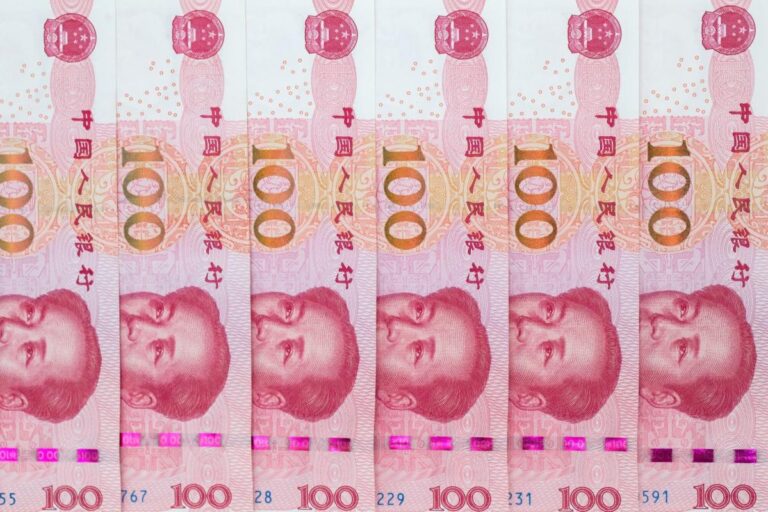
[ad_1]
(Bloomberg) — China is escalating its defense of the yuan, pushing up funding costs in the offshore market to squeeze short positions and setting a new record with its stronger-than-expected reference rate for the currency.
Most Read from Bloomberg
Analysts say the steps are designed to slow the pace of yuan depreciation rather than engineer a sustained rally. Forecasters at JPMorgan Chase & Co., Nomura Holdings Inc. and UBS Wealth Management all predict further weakness in the currency this year. The offshore yuan reversed earlier gains to weaken Tuesday, dropping back toward its 2023 low set last week.
The People’s Bank of China set its daily fixing for the currency at 7.1992 per dollar Tuesday, compared with an average estimate of 7.3103 in a Bloomberg survey. That was the largest gap since the polls began in 2018.
The record positive bias for the fixing came a day after yuan one-month forward points, a measure of the cost to borrow the currency versus the dollar, jumped the most in offshore trading since 2017. Funding costs have climbed in recent days as local banks have refrained from providing more of the currency in the swap market, according to traders. That may make it more expensive for speculators to bet against the yuan.
In another sign of a liquidity squeeze, Hong Kong’s offshore yuan interbank rates climbed to the highest since 2018 on Tuesday.
The yuan has been under pressure for months as China’s economy struggles, and PBOC interest-rate cuts have widened the yield differential with the US. While the central bank is easing its monetary policy, it is also trying to slow the yuan’s decline with stronger-than-expected fixings, dollar sales by state banks, and measures such as tweaking rules on capital flows.
For years, Chinese policymakers have been highly sensitive to any speculator-driven wild yuan swings as any disorderly depreciation may trigger a vicious cycle of excessive declines and capital outflows. In its latest monetary policy report released last week, the central bank said it will resolutely prevent “over-adjustment” in the yuan with an ample reserve of policy tools to manage the currency.
‘Tactical Tool’
“A CNH funding squeeze could be a tactical tool and a signaling device, but unlikely the go-to tool in isolation,” Citigroup Inc. strategists Philip Yin and Gaurav Garg wrote in a client note. “Overall, the combination of rate cut and other FX tools suggest that fundamental-driven yuan weakness is allowed but the pace is managed.”
The PBOC sold 35 billion yuan ($4.8 billion) of bills in Hong Kong Tuesday, exceeding the 25 billion yuan of the securities coming due this month. That was the first time the central bank has refrained from a flat rollover in two years, according to data compiled by Bloomberg. The offering included 20 billion yuan of three-month bills which were sold at 3.2%, the highest yield since 2018.
Other parts of the forward curve are also rising. Tomorrow-next forward points climbed to the highest level since May 2022 on Monday, while the 12-month tenor rose to a three-month high. The spike up in forward points comes after some tenors slid to record lows in recent months, weighed down by the US-China yield divergence. US two-year Treasuries yield about 290 basis points more than similar-maturity Chinese government bonds, the widest spread since 2006.
Draining offshore liquidity may squeeze short positions, but it will also undermine the long-term policy intention for yuan internationalization, said Xiaojia Zhi, chief China economist at Credit Agricole CIB in Hong Kong. This latest step shows “the PBOC is intolerant of rapid one-way moves and would consider various pool tools to discourage speculative flows on CNY depreciation and manage expectations,” she said.
Still, the recent efforts to bolster the yuan may not be enough to prevent further losses given softening consumer spending, sliding home prices and debt repayment pressures facing the local government sector.
“Policy in China is proving to be more tolerant of weaker growth, and more resistant to abandoning its efforts to de-lever the pockets of debt,” strategists at Deutsche Bank AG led by Perry Kojodjojo wrote in a note. “We continue to believe that the natural corollary to this is weakness in the currency and the authorities don’t intend to draw a line in the sand.”
–With assistance from Ye Xie, Ran Li and Abhishek Vishnoi.
Most Read from Bloomberg Businessweek
©2023 Bloomberg L.P.
[ad_2]